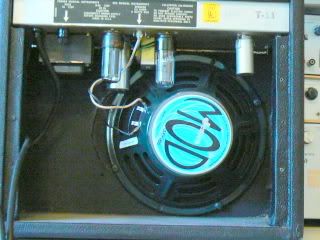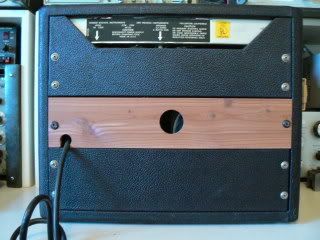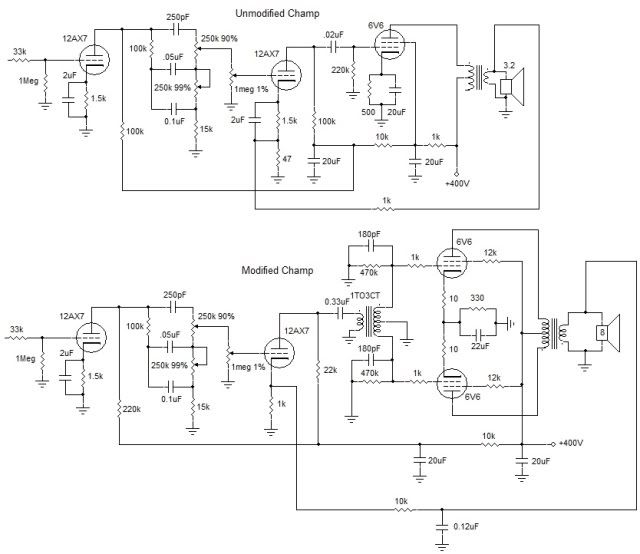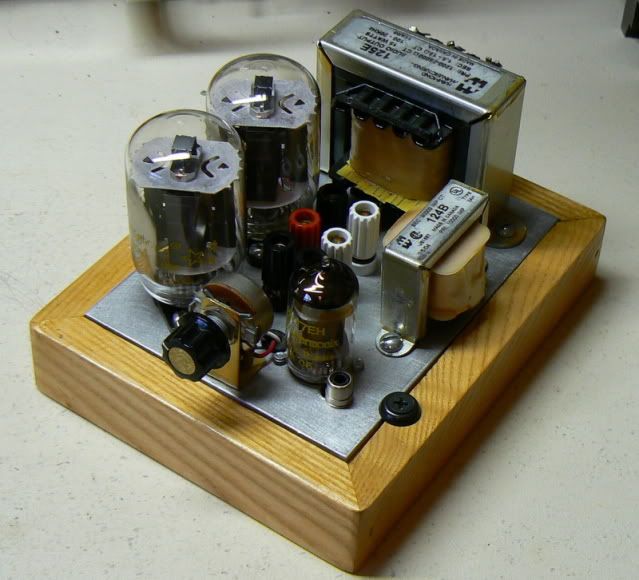-
I cant decide...I play jazz the most, but occasionally have gigs where I want to play with distortion, and other effects. The Henriksen has a line out....but the Princeton is a tube amp...I don't own a tube amp. I just want a nice sounding clean for my jazz gigs and can handle a blues/rock gig but is light weight, preferably one(1) 10 or 12 inch speaker.
Fender Princeton
Henriksen JazzAmp 110
I'll take any other suggestions on an amp that you would think a better choice.
Thanks for your help,
Clayton
-
12-25-2009 09:47 PM
-
$900 seems real pricey to me for a 15 watt two 6v6 amp with a 10" speaker. If you never had a tube amp, save $600 or so, and try a Fender Super Champ XD or whatever it's called that is a 15 watt +/- two 6v6 amp with a 10" speaker and a modelling type pre-amp. And you can rig your own line-out with any combo amp. Just my opinion. Haven't had any Henrikson experience.
-
The Fender looks nice but 15 watts is a bit small for it to stay on the clean side one you put a litle volume on it. It's probably great for a blues rock gig.
Do you have a SS amp now? If so , what? That would be the deciding factor for me. Amps , like guitars, are just tols that serve a purpose. Always use the right tool for the right job
-
If you're playing mostly jazz, go with the Henriksen. Get yourself a good sounding distortion like the TC Electronic Nova Drive for distortion and overdrive effects.
-
The Princeton has very little headroom and the reverb on it sounds extremely artificial. next to that it doesn't have a mid control which really bothered me.
i can't comment on the henriksen though, but it will probably have a lot more headroom and if you place a good overdrive in front of it that might work.
-
Just stirring the pot.
Good luck.
-
yeah, but jim uses older princetons...they really "don't make 'em like they used to."
but i still think the reissues are pretty dang good amps. might not stay clean with a hard hitting drummer, but for a small gig, drumerless group, etc, should be fine. i'm under the impression that most folks play jazz guitar way too loudly anyway. There will certainly be good rock sounds in there too.
the heinriksen is a very different sounding amp, IMO, and i'm surprised you'd even compare the two. If you like the jazz tones an amp like a princeton can get, I'd think you wouldn't like the more modern, dry, cleaner than clean sound of the henriksen. Even if you like both (like me), they're apples and oranges.
i'm a proponent of "different tools, different jobs." If you're gonna play types of music that require vastly different tones, you're either gonna need two amps or, some catch-all modeling amp that might leave you dissapointed as it's a jack of all trades but master of none.
something to consider would be checking the used market for a silverface NON-reverb princeton, if you like the idea of a very portable tube amp. A lot more clean headroom than their reverbed brother (with single coils, they're still essentially "clean" dimed!)
-
I LOVE Princetons but $900 ..... whew ! Here's a possibility for do-it-yourselfer's. I'm a big fan of the Fender Champ, especially the silver-face variety with better EQ and more output power than the original. The advantage of this amplifier is small size and portability. Disadvantages are inadequate power (and headroom) coupled with the small, limited range loudspeaker of non-standard impedance (3.2 ohms).
Since the Champ is so easy to work with (there are large amounts of unused real estate inside the chassis), I've tinkered with mine often. It's been thoroughly manipulated/revised with no audible performance improvement. Some improvement resulted from replacing the speaker and output transformer with a larger 10 inch speaker of normal impedance (8 ohms), as in a Fender "Princeton". (This project has been posted before, I apologize for the repetition but in order to get to the end of the story, it's necessary to start at the beginning and chart the evolution of my amplifier.)
Replacing the speaker wasn't a trivial task, although replacing the transformer was simple. Here's a photo of my Champ with the back removed. The outline of the old 8 inch speaker cut-out is visible, replaced with a piece of plywood cut to fit the hole, epoxied into place and painted. (Note that the 10 inch speaker had to be moved off-center in the enclosure to clear a large electrolytic capacitor mounted on the chassis.)

After replacing speaker and transformer, a listening test left me wanting a more balanced response - the Champ always lacked bass. I measured the frequency response of the new configuration then experimented with partly covering the back of the enclosure until I arrived at this variation, which has a satisfying amount of bass and midrange. One of these days, I'll get around to painting that piece of cedar.

The amplifier as shown with the factory electronics is fine for practice and even for duo/trio performance (no drummer) in small venues. Once a drummer is added, the Champ is impractical. Appreciating the convenience of this small unit, I wondered about increasing the output power. I listed the implications of bringing the Champ up to "Princeton" performance levels (around 12 watts) from the measured 5 watts produced by my Champ at 5% distortion.
The Champ is a single-ended amplifier, doubling the power implies a push-pull output circuit, requiring two output tubes and a phase-splitter tube
Extra tubes = increased current consumption = bigger power supply transformer = $$
Need to cut holes in chassis for additional output tube and phase-splitter tube
Extra output power means that extra gain is required (increasing the power level from 5 to 12 watts means about one and one-half times more voltage gain)
I thought about these things, I wasn't in a hurry and wanted a simple, easy implementation (and one that was readily reversible to restore the original configuration). First, addressing the increased power consumption, I looked up the Fender "Princeton" schematic on the internet and found that the power transformer was the same used on the Champ! That was a step forward - no expensive power transformer to buy, mount and re-wire.
Then I considered addition of the phase-splitter tube. The purpose of the phase-splitter is to divide a single signal into two signals with opposite phasing. It's not necessary to use a tube for this function, it can be done with a small transformer. Since no appreciable power is being transferred, the "interstage" transformer is inexpensive and easy to obtain. I found a 3 : 1 center-tapped transformer for a few dollars. Only two small holes need be drilled in the chassis to mount the transformer. The transformer eliminates one tube and the filament/plate current required to power it.
Addressing the power amplifier stage, I could have replaced the single 6V6 with a single 6L6 plus a few component changes to increase the output power of the single-ended design but that approach would need about 120 milliamperes plate current, requiring a power supply redesign and more $$$. (Push-pull Class AB and B amplifiers are much more efficient, using a pair of 6V6 tubes requires about 70 milliamperes which is within the capability of the Champ power supply transformer.)
Some design changes are required, adding more voltage gain for example. Happily this isn't too difficult and accommodated by changing a few resistor values. Adding the extra transformer in place of the phase-splitter tube does create a disadvantage. Transformers have limited bandwidth and consequently more phase-shift than any other circuit in the amplifier except for the tone controls. And excessive phase shift can cause oscillation if one doesn't account for it.
The solution for this problem was fairly simple. Frequency compensation was added to the two output tubes and to the feedback loop, three more capacitors added to the circuit. Here are the schematics (excluding power supply) of the unmodified Fender Champ and the "Princetonized" version.

Since I liked my Champ in original configuration and didn't want to punch holes in its chassis, I deviated from the planned implementation of the design. I "bread-boarded" the output stage of the amplifier on a universal test chassis (home-built and useful for various tests and design verification). This chassis is small enough to fit comfortably in the bottom of the Champ cabinet, but power supply leads, speaker connections and a shielded cable to the interstage transformer must be routed from the main chassis.

(In the above photograph, the test chassis is configured with other tubes for evaluating a different circuit, however the interstage transformer and output transformer are the ones that I bought for the Champ modification.)
The modification was fun, informative and successful. The measured output power was about 12 watts at 5% distortion. Computer circuit simulations suggest that the output stage is capable of 20 watts (if cathode bias resistors are eliminated and a negative voltage is used to bias the grids of the output tubes). That happens to be my personal recommendation for the amount of power required to play with a drummer.
I'm not actually recommending this project for anything but reading entertainment for 99% of those who may read this. For most people it would be far simpler to buy an amplifier with adequate output power. I did this out of interest as to how far I could extend the Champ concept and I was satisfied with the result.
However if I had a spare $900 and some time on my hands, I'd soon have the world's best-sounding Champ OR Princeton, LOL !
PS: FWIW, reducing the cathode bias resiatance will easily produce 15 watts in the above circuit but the difference in "loudness" was inaudible to me, even when switching in/out the new bias resistor virtually instantaneously. (Since I couldn't hear the difference, I went for tube longevity by reducing power dissipation in the output tubes.)
PPS: A clever person could easily add the outboard Princeton chassis (in the bottom of the Champ enclosure) and by using an octal plug, inserted into the 6V6 socket of the Champ, have a complete Princeton without making a single modification to the Champ other than replacing that ridiculous little speaker. There's an aftermarket business idea for someone ... come to think of it, I don't know why I didn't implement my original idea in exactly that manner -Last edited by randyc; 12-26-2009 at 07:35 PM. Reason: add PS, add PPS
-
Randy,
That is an impressive post - educational too!
Regarding the original question, I think that an amp is as much an instrument as the guitar once you plug in, so it really is a decision you need to make yourself. Especially in this case, since they are very different amps. I also agree that's a lot of $, you might want to look at the classifieds/lists online. I was valuing an old blackface Twin for a friend, and saw some for $400 or slightly more, in good condition. Of course that's a much more powerful (and heavy!) amp, that's just an example.
Do let us know which you choose, & why, and how you like it!
-
I have a Henriksen 112 coming this week and I've played through many Princetons. I'll let you know what I think when I get a chance to have some fun on my Henriksen
-
Well....the Henriksen i dont think will be loud enough to cut through horns, a drummer, bass and piano player. I think im going with the tube amp, i like the warm tube sound, feel, and the overall character....which I think lacks in a lot of jazz guitarists tone. The Henriksen is a great amp...dont get me wrong, I am just looking for that tube sound and character. I already have a solid state and when I play through a tube amp I am blown away. Now I have to decide on what kind of tube amp to buy.
Is there any tube amps out there that you would recommend for playing jazz...smaller 10 or 12 inch, and can handle some horns, drums, bass, and piano.
Any recommendations would help,
Clayton
-
Bassman head with a 12 inch 4 ohm cabinet is quite loud, sounds very nice and isn't excessively heavy (15 inch 4 ohm speaker is REALLY sweet). I don't know how hard it is to find a Bassman these days so I suppose my point is that you probably need something in the 40 - 50 watt power range. I believe that there was an Ampeg re-issue (a Chinese product) a few years back that fit that niche: 50 watts, vacuum tube, 12 inch speaker. Other older Fender amps that would work are the Dual Showman head (overkill but you can pull two tubes and calm it down to 50 watts), Bandmaster head with a cabinet of your choice. These old amp heads are sometimes a real bargain and quite reliable ... I love 'em !
And then there's the Twin
-
There are some amp makers doing tube amps designed for jazz: Matamp, Rivera and Vintage Sound for example. I also corresponded with Wayne at Headstrong about modifying one of his standard models for jazz.
 Originally Posted by cguitardelong
Originally Posted by cguitardelong
-
I find my Fender Blues Deluxe still an ideal amp for jazz. It delivers a sweet, round clean tone with a punch that I like. With it's 40 watts (2x6L6) it delivers more then enough power, and with it's 12" speaker it's portable enough if you travell by car (
 Originally Posted by cguitardelong
Originally Posted by cguitardelong
 ). And it's tweed-covering gives it just the right look too (if you care for that sort of thing). It's too heavy to take in public transport, but I doubt you will find a tubeamp that would be light enough for that and delivers enough power. I have a Peavey Classic 20 (1x10", 2xEL84) but it does not deliver enough overhead (doesn't stay clean) and after walking more than 200 meters with it you are suprised how heavy a small tubeamp can be!
). And it's tweed-covering gives it just the right look too (if you care for that sort of thing). It's too heavy to take in public transport, but I doubt you will find a tubeamp that would be light enough for that and delivers enough power. I have a Peavey Classic 20 (1x10", 2xEL84) but it does not deliver enough overhead (doesn't stay clean) and after walking more than 200 meters with it you are suprised how heavy a small tubeamp can be!
If I play a gig in the centre of town where I can't park my car or if I am forced to take pubic transport, I take my Roland Cube 30..... I find it has just enough power for a quintet with drums and piano, but only just... but even for that amp I bought myself a little trolley and that's realy ideal!
-
a 60w Solid State amp is more then enough to play with any sort of Jazz ensemble including a whole Big band and have enough volume to be able to get up on the band. Volume is not always everything, EQ is just as much a factor in being able to Cut through.
Tube amps offer more presence then solid state amps. But between the Henriksen and the Princeton I honestly don't think there is going to be much difference in volume. I typically play in situations with full rhythm section plus a 1 or 2 horns and use a 60w SS amp or a 40w Tube and I never ever have to worry about being heard, if anything I'm too loud and I don't turn the amp past 4 on my Fender.
-
I'm not sure anything with a single 10" speaker will cut it alone in that situation, but the Henriksen JazzAmp 112 (I have one - Jake, can't wait to hear your reaction) sure will, and it's still only 32 lbs. It's really only a jazz amp, however, though it does seem to 'take' effects well. And, as far as comparisons to tube amps are concerned, it's admittedly not nearly as subjectively loud as the Rivera R55 (47 lbs.) that I sold to finance it.
 Originally Posted by cguitardelong
Originally Posted by cguitardelong
P.S. https://www.jazzguitar.be/forum/guitar-amps-gizmos/6367-henriksen-vs-henriksen.htmlLast edited by Tom Karol; 12-28-2009 at 10:22 AM. Reason: Add P.S.
-
I can't tell you about the Fender as I don't have the one you are looking at; but I've got a Fender Jazz King and a Henriksen. Concerning the latter, if it was just jazz you wanted to play then the Henriksen is great. The EQ system works really well giving extremely slight alterations in tone, but I suspect that if you want distortion as well, then perhaps it's not for you. Similarly with the Jazz King, distortion is not what they were built it for.
Of course, the Henriksen is very light (which is one of the key reasons I bought it) as compared to the Jazz King which ought to come with a free fork lift truck or at least a doctor to put your shoulder back in place.
Nonetheless, I think you are trying to get too many options out of a single amp. Get the Henriksen for jazz (you won't got wrong there), and another Fender for distortion.
-
What?!
 Originally Posted by Abaddon2005
Originally Posted by Abaddon2005
 The reverb on a Princeton Reverb is tube driven, spring reverb. That's as "real" as it gets!
The reverb on a Princeton Reverb is tube driven, spring reverb. That's as "real" as it gets!
-
That's what I expected! but it sounded like there was a cloth hanging over the amp or something, no clarity at all. maybe the tubes in it were old.
-
Same with the Jazz King. Admittedly, some people don't like spring reverbs, but it sounds fine to me. By the way, I didn't mean to give the impression that I didn't like the Jazz King. Quite the contrary. It's a great amp, simple to use (you can use the EQ tilt and leave the rest alone if you like), and with an L4 it really booms out with a well-rounded sound. But for distortion, forget it....and I simply can't lift the thing.
 Originally Posted by martinopass
Originally Posted by martinopass
Last edited by Ged; 12-30-2009 at 01:20 PM.
-
spring reverb IS artificial. reverberation is a natural occurrence, so actually, "room" and "hall" digital reverbs are the most "natural" sounding.
that said, spring reverb can be great in the right instances. I always felt that few did it better than fender.
-
Ah, very good point. But for me, reverb in regard to it being built into amps, spring reverb is what I consider the "real" thing in that regard...and that Fender was the best at it. But you're right in that spring reverb was/is essentially an emulation of natural reverb you get in a room/hall/etc.
 Originally Posted by mr. beaumont
Originally Posted by mr. beaumont
I do find, when I use digital reverb, that I lean towards the ones that emulate spring reverb. Probably because it's what I grew up with on my amps and still do have on a couple of my amps.
-
Well I decided to go with a Fender Blues Deluxe....amazing. Exactly what I was looking for, great jazz tone, light weight, not awkward to handle (compared to a JC-120), cuts through the mix....and great overdriven tube distortion. I love it! Thanks for the help guys! I played a Princeton, a Blues Junior, and the Blues Deluxe and love the the headroom, power, and tone of the Blues Deluxe the most! I can carry my guitar and the amp together...something I couldn't do with the JC-120.
-
those princeton reissues have bunk speakers in them. not to mention transformers, caps, and pretty much everything else. cant get above 3 on the volume without the bass farting out.
i was looking into real deal blackface ones for a while but they go for around $2500. i ended up with a headstrong lil king with a 50 watt 10" weber speaker in it. all the of the BF characteristics, you can crank it, and about half the $$$. sounds great for just about anything.
-
I have a SF Princeton loaded with a 12" alnico speaker (weber sig). The 12" speaker has more headroom than the stock 10". I play this amp with a '59 framus blackrose with a floating mini hb, for practicing, recording and (miked) also gigs with a gentle drummer. The tone is impressive.
I am thinking about adding an external cabinet, loaded with a ceramic speaker. It could provide bigger punch and some more headroom.




 Reply With Quote
Reply With Quote







2 new & excellent Jazz Comping Truefire...
Today, 10:22 PM in Comping, Chords & Chord Progressions